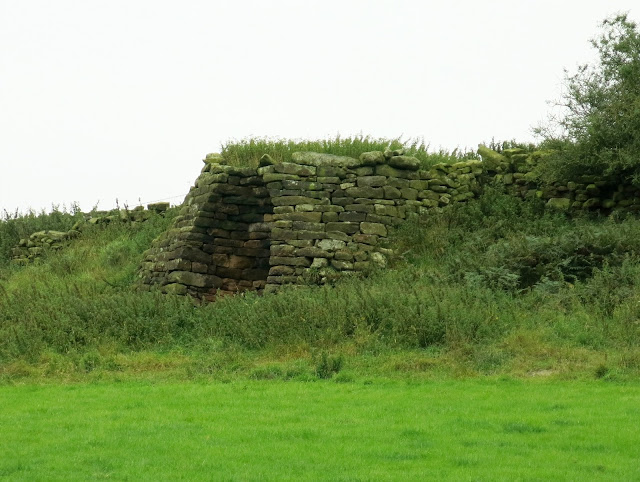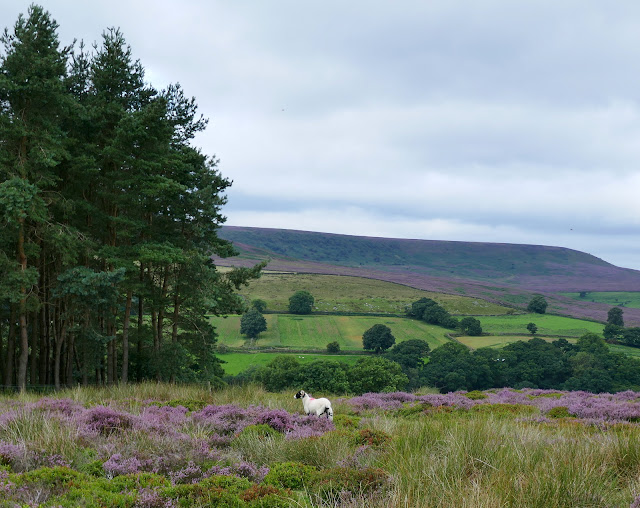Hazel Head to Arnsgill and Cow Ridge
7 miles Fine and still
We approached Hazel Head Car Park via a 6 mile drive along the unclassified road from Osmotherley to Hawnby and after driving past the ford at Blow Gill ('ravine with the dark ford') we parked at Hazel Head car park.
After donning our boots we returned along the road, back to Blow Gill where we admired an old lime kiln at the side of the road, the first of three we would pass today.
 |
| Today's walk from The Walker's Guide to the Cleveland Hills |
 |
| Blow Gill |
 |
Limekiln at Blow Gill
|
Tom Scott Burns explains that a number of farmers in the region had their own lime kilns for burning lime, which was used for lime washing walls and dressing the land, a custom going back to Roman times. The lime neutralises the acid in the moorland soil allowing more varied crops to be grown. Leaving Blow Gill we followed the road steeply uphill to reach the entrance to Street Gate Farm, where we turned left onto the farm track.
 |
| Passing Street Gate Farm |
 |
| Trap near Street Gate |
The farm track is overgrown and very muddy in places. It leads past Street Gate Farm and into South Wood. This is an old lane and TSB tells how these lanes were used by tinkers and pedlars who became very numerous in the Middle Ages. These travelling salesmen not only sold their goods but also played a big part in circulating news and delivering letters between settlements.The track led us past another farm, Hagg House, and on until we reached Birk Wood Farm where we turned right just before the building and climbed steeply to rejoin the Osmotherley to Hawnby road. Here we paused to examine another lime kiln, which probably once belonged to Plane Tree farm.
 |
| Hagg House Farm |
 |
| Old lane |
 |
| Gets muddy in places |
 |
| Turn right onto tarmac at Birkwood Farm |
.JPG) |
| Lime kiln near Plane Tree Farm |
We left the Lane at a gate opposite the Birkwood Farm entrance, to start another steep climb to reach the moor. Passing the moor gate we walked along the edge of the moor, looking west to the grand building of Snilesworth Lodge. Eventually the path drops from the moor to reach Arnsgill Beck which is crossed by a footbridge, just before Hill End Farm.
 |
| Easterside Hill and Hawnby Hill in the distance |
 |
| Moor gate |
 |
| Heather honey |
 |
| Busy bees |
 |
| Overpowering scent of heather pollen |
 |
| Keeper's cottage below |
 |
| Descending to Arnsgill Beck |
There were bees buzzing everywhere in the flowering heather and a very strong smell of pollen as we crossed the moor. Later, on the way home, we would stop at a roadside stall in Osmotherley and buy honey collected from the hives we passed near Plane Tree Farm.
Climbing from Arnsgill Beck we passed Hill End Farm and walked on to Arnsgill Ridge with Snilesworth Moor to our left. TSB says that in 1150 Snilesworth was written as Snigleawath, meaning Snigels' Ford, based on the Norse word snigill, a snail.
 |
| Hill End Farm |
 |
| Lime Kiln at Hill End Farm |
 |
| Snilesworth Lodge |
Our climb took us past the farm to the top of Arnsgill Ridge where we joined a shooters' track to pass through the moor gate and walk towards a distant plantation of conifers. We followed the track until it drops down to Head House.
 |
| Stoat trap |
 |
| Head House |
Head House is always unlocked and makes a good shelter in bad weather but today we walked on and dropped down to re-cross Arns Gill and then climbed to Cow Ridge. We strode out along the moor path for a couple of miles.
We came to a cairn which marked the location of Iron Howe. TSB points out that all along this stretch are well preserved field boundaries and over 300 cairns dating from 2300 to 800BC. Although they don't show well in the photographs they are in fact very noticeable as you walk along this stretch of the path.
 |
| Iron Howe |
 |
| Remains of ancient settlements |
After Iron Howe we descended gradually back towards Blow Gill.
On our left we spotted the old Wesleyan Chapel ruins, where we have stopped to rest on TSB's Hawnby to Hazel Head walk. Below us we saw the unusually named Scotland Farm, and now on tarmac we dropped back to Blow Gill and the end of the walk.
 |
| Scotland Farm |
 |
| Wesleyan Chapel ruin |
 |
| The end of the walk |









.JPG)


































































































